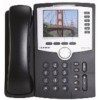Cisco SPA962-NA Administration Guide - Page 53
Entering and Saving Settings, Input Mode, Soft Key, Cursor appending, Cursor inserting
 |
View all Cisco SPA962-NA manuals
Add to My Manuals
Save this manual to your list of manuals |
Page 53 highlights
Chapter 3 Managing Linksys 900 Series IP Phones Using the LCD Display Entering and Saving Settings The 900 Series phone GUI lets the user enter alphanumeric and numeric inputs. The following data types may be entered into the phone: • Numeric string, such as a phone number when dialing • Alphanumeric string, such a name when adding a directory entry • IP address, such as a DNS server IP address • Boolean (y/n), such as enabling or disabling the DHCP option or selecting a preferred audio device or ring tone When two or more numeric string, alphanumeric string, and IP address types can apply to an entry, the phone shows a soft key for switching input modes among the applicable types. The soft keys changes when pressed to allow the user to scroll through the available modes, such as num, alpha, or IP. The cursor also changes according to Table 3-3, to indicate the input mode being used: Table 3-3 Input Modes Input Mode Numeric Alphanumeric IP Address Soft Key num alpha IP Cursor (appending) Cursor (inserting) Blinking underscore _ Blinking vertical line | Blinking full-height Blinking open block ¶ rectangle . Blinking half-height Blinking half block . rectangle . When entering digits in numeric mode, enter the corresponding digits from the numeric key pad. When entering letters or symbols during alphanumeric mode, the phone shows a template of two or more choices as the user presses each digit key. The user scrolls through the choices by pressing the same key multiple times. To accept a symbol as input, the user does one of the following: • Stop pressing the digit key for 1.5 seconds • Pressing another digit key • Navigate to another input field (if applicable) by pressing the UP/DOWN key, or • Save the value by pressing the proper soft key, such save or ok When entering an IP address, pressing the * digit inserts a dot (.), or a colon (:) if there are 3 dots entered already. When entering numeric, alphanumeric, or IP address values, the following additional soft keys are available for easier editing: • -Move cursor to the right by one character • erase















